The GeForce GTX 760 Roundup: Gigabyte and EVGA Compared
by Ryan Smith on October 7, 2013 2:00 PM ESTOverclocking
Last but not least we have our customary look at overclocking performance. With both cards being custom cards, these cards have some notable differences between them. Chief of which in fact is that only the EVGA card can be overvolted to 1.212v. Gigabyte’s card, though having the overvoltage function exposed via NVIDIA’s drivers, doesn’t actually work, leaving the card at 1.2v max at all times. As a result EVGA’s 760SC ACX will get one more boost bin at a higher voltage to play with than Gigabyte’s card will.
Furthermore there is also a difference in power target adjustability that may also play into EVGA’s hands. The 760SC ACX can have its power target raised by 15%, but the 760OC’s can only be raised by 10%. However if our suspicions are right and Gigabyte has a higher default power target in the first place, then the difference should not significantly handicap the Gigabyte card.
| GeForce GTX 760 Overclocking | |||||
| GTX 760 (Ref) | EVGA GTX 760SC ACX | Gigabyte GTX 760 WF | |||
| Shipping Core Clock | 980MHz | 1072MHz | 1085MHz | ||
| Shipping Max Boost Clock | 1149MHz | 1228MHz | 1215MHz | ||
| Shipping Memory Clock | 6GHz | 6GHz | 6GHz | ||
| Shipping Max Boost Voltage | 1.2v | 1.2v | 1.2v | ||
| Overclock Core Clock | 1130MHz | 1130MHz | 1185MHz | ||
| Overclock Max Boost Clock | 1306MHz | 1300MHz | 1306MHz | ||
| Overclock Memory Clock | 6.5GHz | 6.5GHz | 6.8GHz | ||
| Overclock Max Boost Voltage | 1.212v | 1.212v | 1.2v | ||
Starting first with the GPU overclock, it’s interesting to note that we have a wide gap in base clockspeeds attainable, but not in the maximum boost clock each card reaches. As far as base clocks are concerned Gigabyte achieves 1185MHz versus EVGA’s 1130MHz, which is 100Mhz (9%) and 58MHz (5%) over stock respectively. But at the maximum boost clock it’s 1306Mhz for Gigabyte and 1300MHz for EVGA, a difference between the cards of only 6MHz, making it a practical tie. The fact of the matter is that these cards will rarely reach their maximum boost bins and we expect there to still be some kind of a performance difference, but it means they’re going to spend most of their time on equal footing, more so than the base clocks would have us believe.
Meanwhile, like GPU overclocking memory overclocking sees the Gigabyte achieve the better overclock. Here the 760OC tops out at 6.8GHz while the 760SC ACX tops out at 6.5GHz. 6.5GHz is fairly common for a GK104 card, while 6.8GHz would be doing better than average in our experience. We are definitely memory bandwidth limited at times even on the lower performance GTX 760, so the 5% additional memory bandwidth may be useful for Gigabyte. The question going into our testing will be whether Gigabyte’s higher memory overclock and higher base GPU overclock will give them a significant boost, or if TDP restrictions and similar maximum boost clocks will keep the two cards close together.
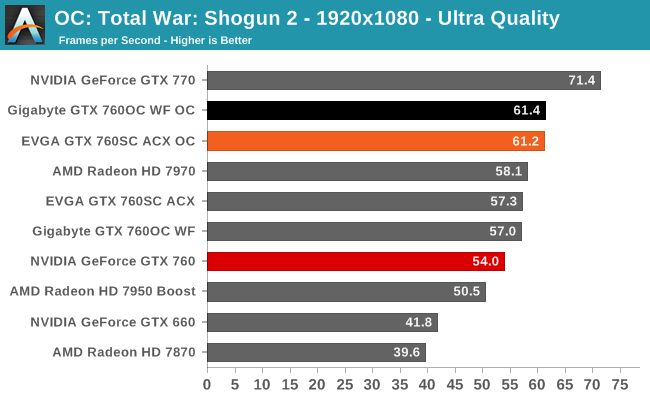
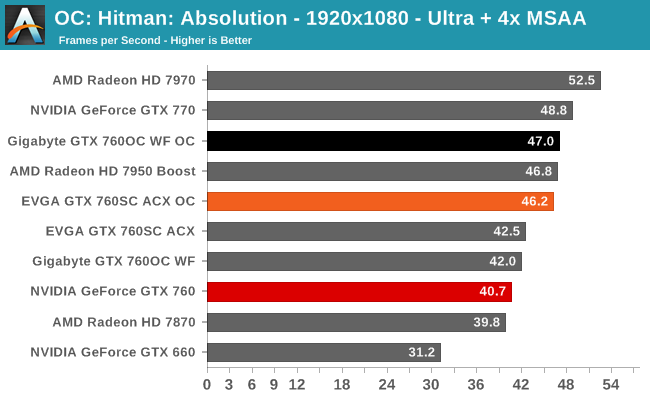
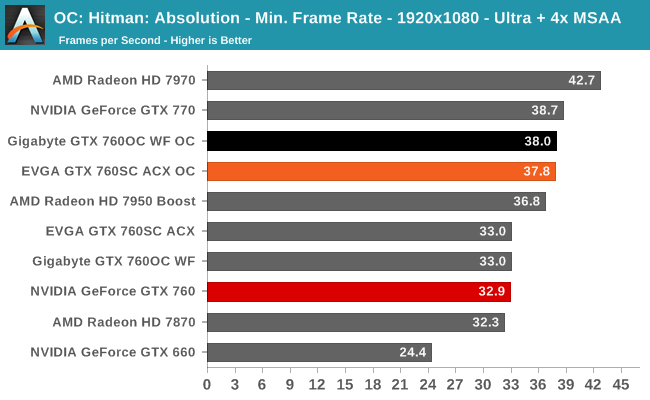
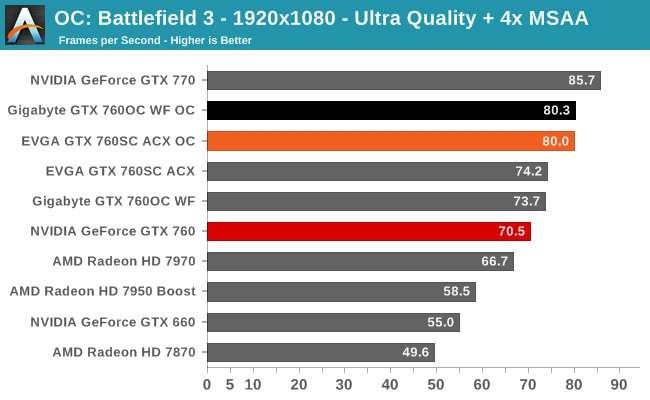
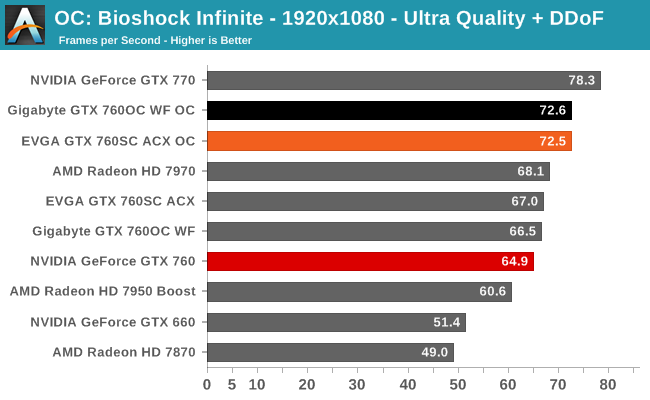
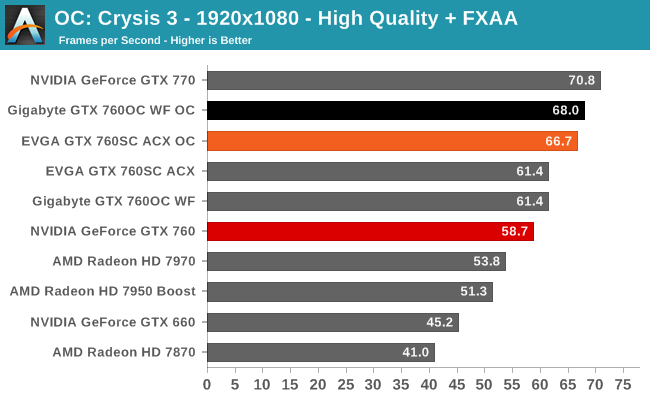
Ultimately the performance differences between the two cards when overclocked is under 2%, despite the higher base and memory overclocks on the Gigabyte card. Gigabyte is consistently in the lead here, even if by just 1/10th of a frame per second, but it’s barely over what experimental variation would give us. Looking at the two cards there’s no reason not to take 2% more performance, but it’s not going to make much of a difference.
With that said, both cards do well for themselves here on an absolute basis due to the combination of their GPU and memory overclocks. The end result of all over this overclocking is 9%-11% improved performance versus their out of the box performance, and upwards of 15% over a stock clocked GTX 760. These are very solid performance improvements, so we’ll have to see what the power and acoustic costs will be.

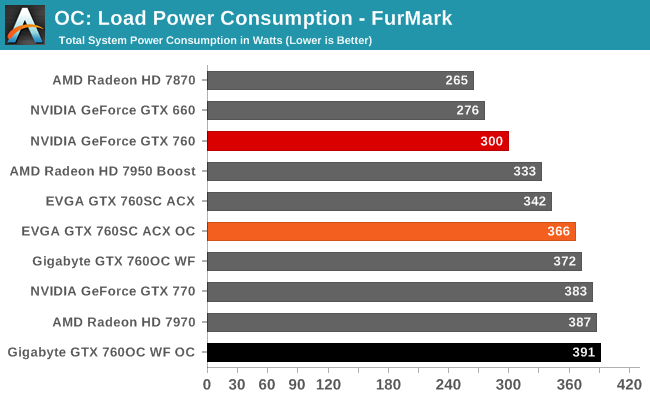
Moving on to evaluating the power, temperature, and acoustic costs of overclocking, as we can see the power costs of overclocking are low-to-moderate. For the Gigabyte card the difference is 23W at the wall under BF3, and a smaller 19W under FurMark. Considering we can’t access the overvoltage boost bin on this card this is a fairly reasonable increase in power consumption, though as with overclocking the reference GTX 760 we are pushing the card off of its ideal performance/power regardless.
Meanwhile for the EVGA card the power cost is just 11W under BF3, and 24W under FurMark. The latter is due to the larger power target increase the EVGA card allows (15% versus 10%) while the BF3 power increase is actually lower that what we’d expect; the reference GTX 760 with similar voltages and power target options saw an almost 40W increase here. This outcome actually equalizes the EVGA and Gigabyte cards a bit under BF3, though with both cards we’re now approaching the power consumption of the stock GTX 770.
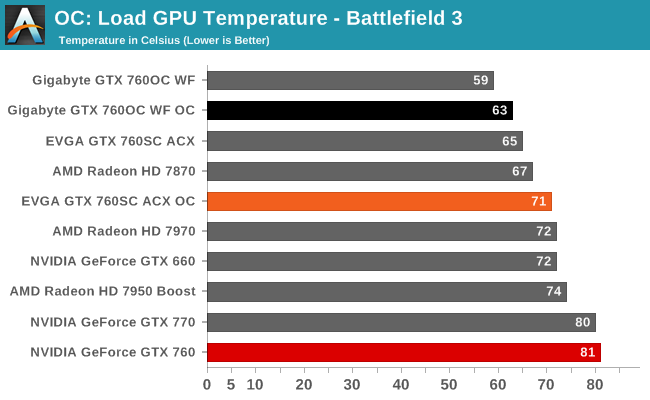
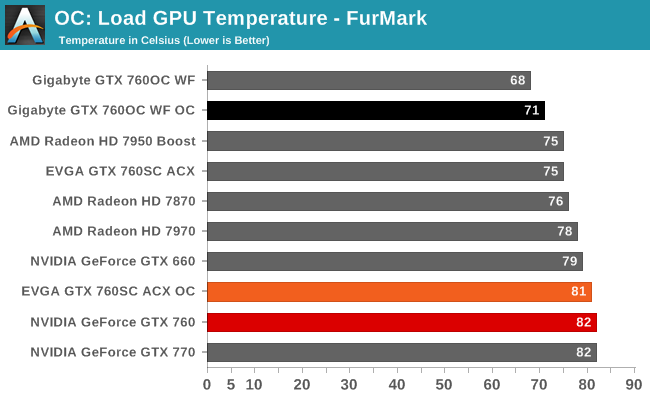
Overclocking has the usual impact on load temperatures, sending them higher in call cases. The EVGA card gets the worst of it, with temperatures rising by 6C under both test cases. The Gigabyte card fares better in that respect, with temperatures rising by just 3C. The end result is that the gap between the cards only grows, with Gigabyte’s card hitting the 60s under gaming and the 70s under FurMark, while EVGA’s card hits the 70s under gaming and the 80s under FurMark. Though it bears repeating that 81C in this case is not the temperature throttle’s work since all of the throttles, temperature included, are raised when we’re overclocking.
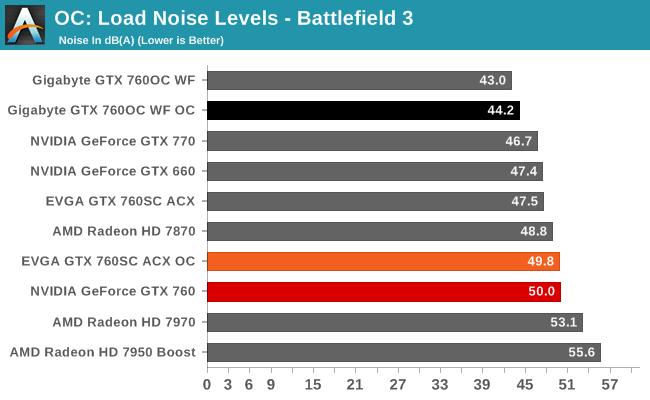
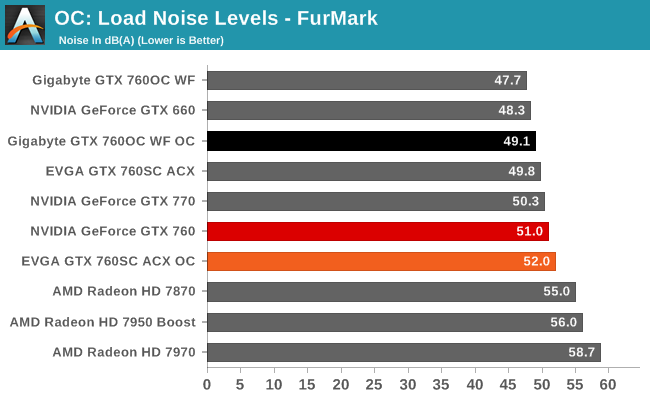
Finally we have the matter of noise, which as is usually the case is going hand-in-hand with temperature. Once more Gigabyte’s card fares the best here, with noise rising a hair over 1dB under both BF3 and FurMark, topping out at 44.2dB and 49.1dB respectively. 44.2dB under a gaming workload isn’t going to be silent, but it’s not too far off of it.
EVGA’s card on the other hand is approaching and exceeding 50dB, with BF3 topping out at 49.8dB while FurMark tops out at 52dB. Like the noise levels under stock, these levels aren’t too far off the mark for an open air cooler when overclocking, but in this case they’re simply not going to be very impressive standing next to the Gigabyte card.
Ultimately overclocking is solidly in Gigabyte’s favor due to cooling considerations. The gaming performance from overclocking their card is not significantly different from the EVGA card and other GTX 760’s we’ve overclocked – which is fairly consistent for GeForce 700 series cards – but what seals the deal for Gigabyte is the fact that even with this overclock they’re still under 45dB for load noise in our gaming workload. Coupled with the lower temperatures and slightly lower power consumption under our gaming workload, and it’s clear Gigabyte is the strongest contender among our GTX 760 cards.










22 Comments
View All Comments
Torrijos - Monday, October 7, 2013 - link
Hi, just wondering what might be the reason for the HD7950 Boost to jump all over the performance charts?That card has a larger memory bus, would it make a difference if you had looked at 2560x1440 ?
gregounech - Monday, October 7, 2013 - link
How is this a roundup when only 2 brands are represented ?Quidam - Monday, October 7, 2013 - link
Agree, it's more like a showdown. I would love to have seen the Asus GTX760 Direct CU II in this roundup as wellmaecenas - Monday, October 7, 2013 - link
Ryan, is Asus not providing test samples? I noticed they were absent from the 770 roundup as wellRyan Smith - Monday, October 7, 2013 - link
We still get samples from Asus. Our next review will include an Asus card.mwildtech - Monday, October 7, 2013 - link
That GB cooler is beast. Change the PCB color to black though, blue represents old school GB..wand3r3r - Monday, October 7, 2013 - link
Considering the 7950 has been hitting $180-190 AR lately, the 760 is overpriced which doesn't even merit a mention in the roundup? NV is rumored to be cutting prices in the next couple weeks so it may even out better at that point, but we'll see.Wreckage - Monday, October 7, 2013 - link
Poor drivers for one.Torrijos - Monday, October 7, 2013 - link
For a single card it isn't the mess crossfire is...Another argument in favour of AMD, free recent games with the cards (should be deduced from the card price to really compare only the hardware price).
Teizo - Monday, October 7, 2013 - link
Just because AMD is doing a price dump to clear inventory doesn't mean the 760 is over priced and irrelevant.